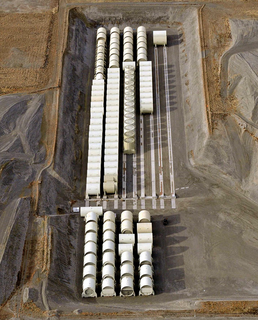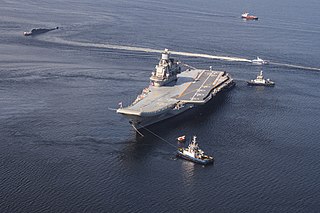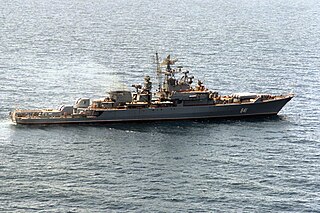
United States naval reactors are nuclear reactors used by the United States Navy aboard certain ships to generate the steam used to produce power for propulsion, electric power, catapulting airplanes in aircraft carriers, and a few more minor uses. Such naval nuclear reactors have a complete power plant associated with them. All U.S. Navy submarines and supercarriers built since 1975 are nuclear-powered by such reactors. There are no commissioned conventional (non-nuclear) submarines or aircraft carriers left in the U.S. Navy, since the last conventional carrier, USS Kitty Hawk, was decommissioned in May 2009. The U.S. Navy had nine nuclear-powered cruisers with such reactors also, but they have since been decommissioned. Reactors are designed by a variety of contractors, then developed and tested at one of several government owned and prime contractor-operated facilities: Bettis Atomic Power Laboratory in West Mifflin, Pennsylvania and its associated Naval Reactors Facility in Idaho, and Knolls Atomic Power Laboratory in Niskayuna, New York and its associated Kesselring site in West Milton, New York, all under the management of the office of Naval Reactors. Sometimes there were full-scale nuclear-powered prototype plants built at the Naval Reactors Facility, Kesselring, and Windsor to test the nuclear plants, which were operated for years to train nuclear-qualified sailors.

The Kuznetsov-class aircraft carrier, Soviet designation Project 1143.5, is a class of fixed-wing aircraft carriers operated by the Russian and Chinese navies. Originally designed for the Soviet Navy, the Kuznetsov-class ships use a ski-jump to launch high-performance conventional aircraft in a STOBAR configuration. The design represented a major advance in Soviet fleet aviation over the Kiev-class carriers, which could only launch VSTOL aircraft. The Soviet Union's classification for the class was as a heavy aircraft-carrying cruiser, which permits the ships to transit the Turkish Straits without violating the Montreux Convention, however the Chinese variants are classified as aircraft carriers.

A ship class is a group of ships of a similar design. This is distinct from a ship type, which might reflect a similarity of tonnage or intended use. For example, USS Carl Vinson is a nuclear aircraft carrier of the Nimitz class.

The Russian Navy is the naval arm of the Russian Armed Forces. It has existed in various forms since 1696, the present iteration of which was formed in January 1992 when it succeeded the Navy of the Commonwealth of Independent States.

Ulyanovsk, Soviet designation Project 1143.7, was a fixed-wing aircraft carrier laid down on 25 November 1988 as the first of a class of Soviet nuclear-powered supercarriers. It was intended for the first time to offer true blue water naval aviation capability for the Soviet Navy. The ship would have been equipped with steam catapults that could launch fully loaded aircraft, representing a major advance over the Kuznetsov class, which could only launch high-powered aircraft from their ski-jumps. However, construction of Ulyanovsk was stopped at about 40% after the dissolution of the Soviet Union in 1991.

The Soviet Navy was the naval warfare uniform service branch of the Soviet Armed Forces. Often referred to as the Red Fleet, the Soviet Navy made up a large part of the Soviet Union's strategic planning in the event of a conflict with the opposing superpower, the United States, during the Cold War period between the two countries. The Soviet Navy played a large role during the Cold War (1945-1991), either confronting the North Atlantic Treaty Organisation in western Europe or power projection to maintain its sphere of influence in eastern Europe.

Soviet Naval Aviation was the naval aviation arm of the Soviet Navy.

Sergey Georgyevich Gorshkov was an admiral of the fleet of the Soviet Union. Twice awarded the title Hero of the Soviet Union, he oversaw the expansion of the Soviet Navy into a global force during the Cold War.

An anti-submarine warfare carrier is a type of small aircraft carrier whose primary role is as the nucleus of an anti-submarine warfare hunter-killer group. This type of ship came into existence during the Cold War as a development of the escort carriers used in the ASW role in the North Atlantic during World War II.

The Kiev class, Soviet designation Project 1143 Krechyet (gyrfalcon), was the first class of both fixed-wing aircraft carriers and battlecruisers built in the Soviet Union for the Soviet Navy.
Novorossiysk is a city in Krasnodar Krai, Russia, founded 1838.

The Moskva class, Soviet designation Project 1123 Kondor (condor) and S-703Project 1123M Kiev, was the first class of operational aircraft carriers built by the Soviet Union for the Soviet Navy.

The Sverdlov-class cruisers, Soviet designation Project 68bis, were the last conventional gun cruisers built for the Soviet Navy. They were built in the 1950s and were based on Soviet, German, and Italian designs and concepts developed prior to the Second World War. They were modified to improve their sea keeping capabilities, allowing them to run at high speed in the rough waters of the North Atlantic. The basic hull was more modern and had better armor protection than the vast majority of the post World War II gun cruiser designs built and deployed by peer nations. They also carried an extensive suite of modern radar equipment and anti-aircraft artillery. The Soviets originally planned to build 40 ships in the class, which would be supported by the Stalingrad-class battlecruisers and aircraft carriers.

Novorossiysk was a conventionally powered aircraft carrier that served the Soviet Navy and the Russian Navy from 1982 to 1993. She was the third Kiev-class vessel to be built. She was designed to engage in offensive actions as a guided missile cruiser mostly using her deck mounted missiles as well as support anti-submarine and surface actions with her embarked air group.

The Pacific Fleet is the Russian Navy fleet in the Pacific Ocean.
Following the dissolution of the Soviet Union at the end of 1991, the Russian Navy struggled to adjust Cold War force structures while suffering severely with insufficient maintenance and a lack of funding. However, improvements in the Russian economy over the first decade of the twenty-first century led to a significant rise in defence expenditure and an increase in the number of ships under construction.
Two ships of the Soviet Navy have been named after the city of Novorossiysk on the Black Sea:

Poryvistyy was a Project 1135 Burevestnik Guard Ship or Krivak-class frigate. Displacing 3,190 tonnes full load, the vessel was armed with the Rastrub-B anti-submarine and anti-shipping missile system. Launched on 16 May 1981, the vessel joined the Pacific Fleet of the Soviet Navy. Over the next decade, exercises with the aircraft carrier Novorossiysk and other members of the Soviet fleet took the ship to Hawaii to demonstrate the capacity of the country to field a blue water navy. Later, the escalating Iran–Iraq War led to the ship being transferred to escorting duties in the Persian Gulf. Between 1987 and 1988, Poryvistyy successfully accompanied 67 merchant ships to safety. After the dissolution of the Soviet Union in 1991, the ship was transferred to the Russian Navy, but, during the following year, was placed in reserve. Decommissioned on 5 June 1994, the ship was sold to a sea club named Vostok to serve as a museum ship. It served in this role until it was damaged by a fire in 1997.

Revnostnyy was a Project 1135M Burevestnik-class Guard Ship or 'Krivak' class frigate that served with the Soviet Navy. Launched on 23 April 1980, the vessel operated as part of the Pacific Fleet as an anti-submarine vessel, with an armament built around the Metel Anti-Ship Complex. Revnostnyy patrolled extensively as far afield as the Arabian Peninsula and Sea of Japan. The ship undertook a friendly visit to India in 1984 and, during the following year, formed part of the escort for a flotilla led by the Soviet aircraft carrier Novorossiysk which helped develop Soviet tactics for carrier-borne aircraft. Taken out of service for an overhaul in 1988, Revnostnyy was instead placed in reserve until 24 July 2003, when the ship was decommissioned and sold to be broken up.














